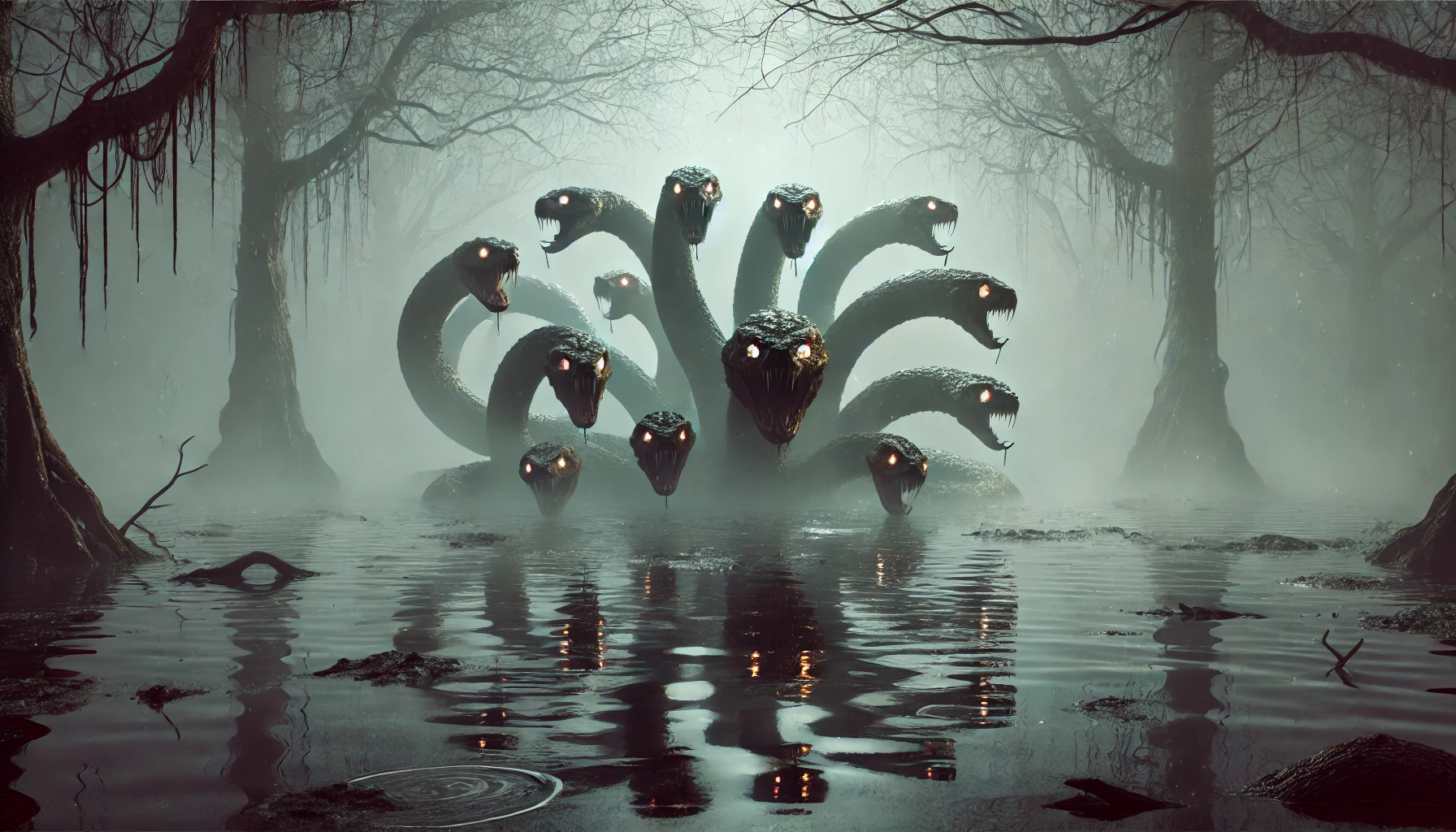The Hydra’s Curse: A Beast That Won’t Stay Dead
The marshes grow unnaturally quiet. No insects hum, no birds call. Then, from the thick mist, a foul stench rolls in—decay, mixed with something else, something sharp and acidic. The water churns, black ripples spreading outward as a mass of writhing necks rise from the mire. Many heads, too many to count, all shifting, twisting, and tasting the air with forked tongues. You should run. But there’s one problem: if you cut off one of its heads, two more take its place.
The Hydra is the apex predator of the ancient world, a serpentine horror that lurks in deep swamps, waiting for prey to wander too close. It is a beast of many heads, each one moving independently, each one with its own deadly set of fangs dripping with venom. Few who claim to have faced it live to tell the tale. Even fewer speak of successfully bringing one down.
Many Heads, One Nightmare: What the Hydra Looks Like
The most well-known Hydra is the Lernaean Hydra, a monstrous serpent said to dwell in the murky waters of Lerna, feared for its regenerative powers and deadly venom. While stories vary, most agree on its terrifying features:
- Multiple Heads: The Hydra’s most infamous trait is its many snake-like heads, which can regenerate when severed. The exact number varies—some legends claim nine, while others say it grows new ones indefinitely.
- Venomous Blood: Its wounds bleed a deadly toxin, capable of poisoning water sources and weakening those who come into contact with it.
- Massive Size: Towering over the tallest man, its thick-scaled body moves with surprising speed despite its bulk.
- Deadly Fangs: Each head can strike independently, injecting venom potent enough to kill with a single bite.
- Near-Immortality: Without the proper method, it cannot be killed—cutting off its heads only makes it stronger.
Accounts of the Hydra vary across regions:
-
- The Lernaean Hydra (most well-documented) had regenerating heads and was nearly impossible to slay without fire.
-
- Some records describe Hydras with just a few heads, rather than infinite regeneration.
-
- In medieval bestiaries, Hydras were sometimes depicted as multi-headed dragons with no regenerative abilities but equally fearsome.
Whispers from the Marsh: Encounters with the Hydra
The most well-documented encounter with a Hydra comes from the legend of Heracles (Hercules), who was tasked with slaying the Lernaean Hydra as one of his Twelve Labors. The battle was nearly his undoing. Every time he struck down one of the Hydra’s heads, two more sprouted in its place. The monster’s venom was so potent that even its breath was lethal. Only by burning the stumps of each severed head with fire did Heracles finally stop its regeneration, and in the end, he buried the final immortal head beneath a massive rock.
Travelers have disappeared in the swamps of Lerna, warriors have ventured in and never returned. Even after the supposed defeat of the Hydra, rumors persisted that other Hydras still lurked in hidden corners of the world.
Where the Hydra Lurks: Its Marshy Domain
Hydras favor wet, desolate places—murky swamps, deep marshes, and stagnant lakes. Any place where thick fog clings to the water and twisted trees loom over the banks could hide one.
Signs You May Be in Hydra Territory:
- No Wildlife Sounds: The presence of a Hydra drives all animals away.
- Rotten Stench: Its venom and acidic blood taint the air with the smell of decay.
- Unnatural Stillness: The waters may ripple unnaturally, as if something massive lurks just beneath.
The Hydra’s Weapons: Fangs, Venom, and Unstoppable Regrowth
- Head Regeneration: Cut off a head, and two more will take its place unless burned immediately.
- Lethal Venom: Even the slightest scratch from its fangs can kill within minutes.
- Venomous Blood: Wounds inflicted on the Hydra release a deadly toxin, capable of poisoning water sources and sapping the strength of any who come into contact with it.
- Relentless Agility: Though it moves like a snake, its sheer size and speed make it a force of destruction, able to coil around prey and overpower them.
Surviving the Hydra: What to Do If You Encounter One
If you encounter a Hydra, your best option is to flee. However, if escape is impossible, consider these survival tips:
- Fire is your greatest weapon. If you must sever a head, immediately cauterize the wound with flame.
- Avoid its breath and blood. Avoid sudden movements—the Hydra detects vibrations more than sight. Even if you aren’t bitten, inhaling too much of its venomous fumes can be fatal.
- Do not engage alone. Heracles needed help—so will you.
- Look for weaknesses. Some say a Hydra’s central body is its true weak spot, though striking it is near impossible with all its heads defending it.
- Poison against poison? In some myths, warriors coated their blades in their own deadly toxins to counteract the Hydra’s regeneration.
Deadly Trophies: What’s Left Behind from the Hydra
- Hydra Venom: Heracles later used the Hydra’s venom to coat his arrows, making them among the deadliest weapons in mythology.
- Hydra Teeth: Ancient myths speak of their use in poisons and weapons, but some stories attribute them mystical properties—though these claims remain unverified.
One Last Warning: When the Hissing Begins, You Run
Hydras are not just stories—they are lurking terrors of the marsh, their presence marked by vanished travelers and silent waters. Travelers who vanish near old swamps and marshes often leave behind no trace—signs that a Hydra may have been hunting.
If you’re unlucky enough to hear that unnatural hissing in the mist, you may have wandered into its hunting ground—leave quickly before it notices you. Turn around. Run. And whatever you do, don’t stop.



